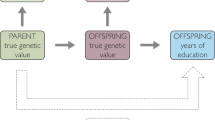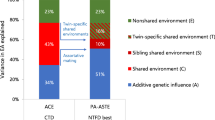Abstract
Families transmit genes and environments across generations. When parents’ genetics affect their children’s environments, these two modes of inheritance can produce an ‘indirect genetic effect’. Such indirect genetic effects may account for up to half of the estimated genetic variance in educational attainment. Here we tested if indirect genetic effects reflect within-nuclear-family transmission (‘genetic nurture’) or instead a multi-generational process of social stratification (‘dynastic effects’). We analysed indirect genetic effects on children’s academic achievement in their fifth to ninth years of schooling in N = 37,117 parent–offspring trios in the Norwegian Mother, Father, and Child Cohort Study (MoBa). We used pairs of genetically related families (parents were siblings, children were cousins; N = 10,913) to distinguish within-nuclear-family genetic-nurture effects from dynastic effects shared by cousins in different nuclear families. We found that indirect genetic effects on children’s academic achievement cannot be explained by processes that operate exclusively within the nuclear family.
This is a preview of subscription content, access via your institution
Access options
Access Nature and 54 other Nature Portfolio journals
Get Nature+, our best-value online-access subscription
$29.99 / 30 days
cancel any time
Subscribe to this journal
Receive 12 digital issues and online access to articles
$119.00 per year
only $9.92 per issue
Buy this article
- Purchase on Springer Link
- Instant access to full article PDF
Prices may be subject to local taxes which are calculated during checkout

Similar content being viewed by others
Data availability
The data analysed in the study are administrative data maintained by Statistics Norway and genotype data from MoBa Genetics. The data are not publicly available, but available to researchers upon application to the respective data owners. Such applications require approval by the appropriate ethics/research data access authorities. Access to administrative data from Statistics Norway can be applied for at Statistics Norway (http://www.ssb.no/mikrodata/) and access to MoBa Genetics can be applied for at the Norwegian Public Health Institute (http://www.fhi.no/studier/moba/). In Norway, the appropriate ethics and research data boards are the Regional Committee on Medical Research Ethics (REK) or SIKT. The consent given by the MoBa participants does not open for storage of data on an individual level in repositories or journals.
Code availability
No custom computer code was used in the study. The software used in the data preparation and analysis were R 4.0, LDpred2 and plink 1.9. R scripts for data preparation and analysis are available at http://github.com/torkildl/nurturenature.
References
Lundborg, P., Nordin, M. & Rooth, D. O. The intergenerational transmission of human capital: the role of skills and health. J. Popul. Econ. 31, 1035–1065 (2018).
Silventoinen, K. et al. Genetic and environmental variation in educational attainment: an individual-based analysis of 28 twin cohorts. Sci. Rep. 10, 12681 (2020).
Young, A. I. et al. Relatedness disequilibrium regression estimates heritability without environmental bias. Nat. Genet. 50, 1304–1310 (2018).
Howe, L. J. et al. Within-sibship genome-wide association analyses decrease bias in estimates of direct genetic effects. Nat. Genet. 54, 581–592 (2022).
Lee, J. J. et al. Gene discovery and polygenic prediction from a genome-wide association study of educational attainment in 1.1 million individuals. Nat. Genet. 50, 1112–1121 (2018).
Okbay, A. et al. Genome-wide association study identifies 74 loci associated with educational attainment. Nature 533, 539–542 (2016).
Sacerdote, B. Nature and nurture effects on children’s outcomes: what have we learned from studies of twins and adoptees? Handb. Soc. Econ. 1A, 1–30 (2011).
Branigan, A. R., McCallum, K. J. & Freese, J. Variation in the heritability of educational attainment: an international meta-analysis. Soc. Forces 92, 109–140 (2013).
Demange, P. A. et al. Estimating effects of parents’ cognitive and non-cognitive skills on offspring education using polygenic scores. Nat. Commun. 13, 2022.
Liu, H. Social and genetic pathways in multigenerational transmission of educational attainment. Am. Sociol. Rev. 83, 278–304 (2018).
Kong, A. et al. The nature of nurture: effects of parental genotypes. Science 359, 424–428 (2018).
Bates, T. C. et al. The nature of nurture: using a virtual-parent design to test parenting effects on children’s educational attainment in genotyped families. Twin Res. Hum. Genet. 21, 73–83 (2018).
Wang, B. et al. Robust genetic nurture effects on education: a systematic review and meta-analysis based on 38,654 families across 8 cohorts. Am. J. Hum. Genet. 108, 1780–1791 (2021).
Belsky, D. W. et al. Genetic analysis of social-class mobility in five longitudinal studies. Proc. Natl Acad. Sci. USA 115, E7275–E7284 (2018).
Okbay, A. et al. Polygenic prediction of educational attainment within and between families from genome-wide association analyses in 3 million individuals. Nat. Genet. 54, 437–449 (2022).
Belsky, D. W. et al. Genetics and the geography of health, behaviour and attainment. Nat. Hum. Behav. 3, 576–586 (2019).
Abdellaoui, A. et al. Genetic correlates of social stratification in Great Britain. Nat. Hum. Behav. 3, 1332–1342 (2019).
Wertz, J. et al. Genetics of nurture: a test of the hypothesis that parents’ genetics predict their observed caregiving. Dev. Psychol. 55, 1461–1472 (2019).
Belsky, D. W. et al. The genetics of success: how single-nucleotide polymorphisms associated with educational attainment relate to life-course development. Psychol. Sci. 27, 957–972 (2016).
Morris, T. T., Davies, N. M., Hemani, G. & Smith, G. D. Population phenomena inflate genetic associations of complex social traits. Sci. Adv. 6, eaay0328 (2020).
Koellinger, P. D. & Harden, K. P. Using nature to understand nurture. Science 359, 386–387 (2018).
Selzam, S. et al. Comparing within- and between-family polygenic score prediction. Am. J. Hum. Genet. 105, 351–363 (2019).
Domingue, B. W. & Fletcher, J. Separating measured genetic and environmental effects: evidence linking parental genotype and adopted child outcomes. Behav. Genet. 50, 301–309 (2020).
Cheesman, R. et al. Comparison of adopted and nonadopted individuals reveals gene–environment interplay for education in the UK Biobank. Psychol. Sci. 31, 582–591 (2020).
Brumpton, B. et al. Avoiding dynastic, assortative mating, and population stratification biases in Mendelian randomization through within-family analyses. Nat. Commun. 11, 3519 (2020).
Wertz, J. et al. Using DNA from mothers and children to study parental investment in children’s educational attainment. Child Dev. 00, cdev.13329 (2019).
Yengo, L. et al. Imprint of assortative mating on the human genome. Nat. Hum. Behav. 2, 948–954 (2018).
Robinson, M. R. et al. Genetic evidence of assortative mating in humans. Nat. Hum. Behav. 1, 0016 (2017).
Border, R. et al. Assortative mating biases marker-based heritability estimators. Nat. Commun. 13, 660 (2022).
Zaidi, A. A. & Mathieson, I. Demographic history mediates the effect of stratification on polygenic scores. eLife 9, e61548 (2020).
Mostafavi, H. et al. Variable prediction accuracy of polygenic scores within an ancestry group. eLife 9, e48376 (2020).
Young, A. S. Estimation of indirect genetic effects and heritability under assortative mating. Preprint at bioRxiv https://doi.org/10.1101/2023.07.10.548458 (2023).
Demange, P. A. et al. Investigating the genetic architecture of noncognitive skills using GWAS-by-subtraction. Nat. Genet. 53, 35–44 (2021).
Isungset, M. et al. Social and genetic effects on educational performance in early adolescence. Proc. Natl. Acad. Sci. 119 https://doi.org/10.3386/w28498 (2021).
Zeeuw, E. L. de et al. Intergenerational transmission of education and ADHD: effects of parental genotypes. Behav. Genet. 50, 221–232 (2020).
Trejo, S. & Domingue, B. W. Genetic nature or genetic nurture? Introducing social genetic parameters to quantify bias in polygenic score analyses. Biodemography Soc. Biol. 64, 187–215 (2018).
Fletcher, J., Wu, Y., Li, T. & Lu, Q. Interpreting polygenic score effects in sibling analysis. Preprint at bioRxiv https://doi.org/10.1101/2021.07.16.452740 (2021).
Veller, C. & Coop, G. Interpreting population and family-based genome-wide association studies in the presence of confounding. Preprint at bioRxiv https://doi.org/10.1101/2023.02.26.530052 (2023).
Krokstad, S. et al. Cohort profile: the HUNT study, Norway. Int. J. Epidemiol. 42, 968–977 (2013).
Magnus, P. et al. Cohort profile update: The Norwegian Mother and Child Cohort Study (MoBa). Int. J. Epidemiol. 45, 382–388 (2016).
Carlin, J. B., Gurrin, L. C., Sterne, J. A., Morley, R. & Dwyer, T. Regression models for twin studies: a critical review. Int. J. Epidemiol. 34, 1089–1099 (2005).
Acknowledgements
We thank the Norwegian Institute of Public Health (NIPH) for generating high-quality genomic data. This research is part of the HARVEST collaboration, supported by the Research Council of Norway (#229624). We also thank the NORMENT Centre for providing genotype data, funded by the Research Council of Norway (#223273), South East Norway Health Authority and KG Jebsen Stiftelsen. We further thank the Center for Diabetes Research, the University of Bergen for providing genotype data and performing quality control and imputation of the data funded by the ERC AdG project SELECTionPREDISPOSED, Stiftelsen Kristian Gerhard Jebsen, Trond Mohn Foundation, the Research Council of Norway, the Novo Nordisk Foundation, the University of Bergen and the Western Norway health authorities (Helse Vest) The Norwegian Mother, Father and Child Cohort Study is supported by the Norwegian Ministry of Health and Care Services and the Ministry of Education and Research. We are grateful to all the participating families in Norway who take part in this on-going cohort study. M.G.N. is supported by ZonMW grants 849200011 and 531003014 from The Netherlands Organisation for Health Research and Development, a VENI grant awarded by NWO (VI.Veni.191 G.030), and NIH grant R01MH120219. K.P.H. is supported by grant R01HD092548 from the Eunice Kennedy Shriver National Institute of Child Health and Human Development (NICHD), and by NICHD grant P2CHD042849 awarded to the Population Research Center at The University of Texas at Austin. D.W.B. was supported by US National Institute on Aging grants R01AG066887, R01AG073402, Russell Sage Foundation BioSS Grant 1810-08987, and the Canadian Institute for Advanced Research. E.v.B. is supported by ZonMw grant 531003014 and NWO Gravitation grant 024.001.003. T.H.L. and T.B. are supported by Horizon2020 ERC Consolidator grant #818420 OPENFLUX. M.G.N., D.W.B., K.P.H. and E.v.B. are all past or present Jacobs Foundation Research Fellows. The funders had no role in study design, data collection and analysis, decision to publish or preparation of the manuscript.
Author information
Authors and Affiliations
Contributions
M.G.N., D.W.B., K.P.H. and T.H.L. designed the study. T.H.L. prepared data. M.G.N. and T.H.L. analyzed data. M.G.N., D.W.B., K.P.H., T.B., O.A.A., E.Y., E.v.B. and T.H.L. interpreted results. M.G.N., D.W.B., K.P.H. and T.H.L. wrote the paper. All authors provided critical comments and feedback on the manuscript.
Corresponding author
Ethics declarations
Competing interests
The authors declare no competing interests.
Peer review
Peer review information
Nature Human Behaviour thanks Andrea Allegrini, Qiongshi Lu, Hilary C. Martin and the other, anonymous, reviewer(s) for their contribution to the peer review of this work.
Additional information
Publisher’s note Springer Nature remains neutral with regard to jurisdictional claims in published maps and institutional affiliations.
Supplementary information
Supplementary Information
Supplementary power analysis and discussion, FAQ, Tables 1–5 and Figs. 1–11.
Rights and permissions
Springer Nature or its licensor (e.g. a society or other partner) holds exclusive rights to this article under a publishing agreement with the author(s) or other rightsholder(s); author self-archiving of the accepted manuscript version of this article is solely governed by the terms of such publishing agreement and applicable law.
About this article
Cite this article
Nivard, M.G., Belsky, D.W., Harden, K.P. et al. More than nature and nurture, indirect genetic effects on children’s academic achievement are consequences of dynastic social processes. Nat Hum Behav 8, 771–778 (2024). https://doi.org/10.1038/s41562-023-01796-2
Received:
Accepted:
Published:
Issue Date:
DOI: https://doi.org/10.1038/s41562-023-01796-2
This article is cited by
-
Genetic similarity between relatives provides evidence on the presence and history of assortative mating
Nature Communications (2024)



